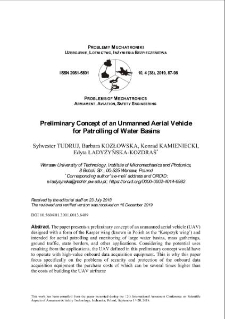Our Digital Library contains 1 868 digital objects
Object
Title: Preliminary Concept of an Unmanned Aerial Vehicle for Patrolling of Water Basins
Alternative title:
Wstępna koncepcja bezzałogowego statku powietrznego służącego do patrolowania akwenów wodnych
Contributor:
Barbara KOZŁOWSKA, Konrad KAMIENIECKI, Edyta ŁADYŻYŃSKA-KOZDRAŚ
Abstract:
The paper presents a preliminary concept of an unmanned aerial vehicle (UAV) designed with a form of the Kasper wing (known in Polish as the ‘Kasprzyk wing’) and intended for aerial patrolling and monitoring of large water basins, mass gatherings, ground traffic, state borders, and other applications. Considering the potential uses resulting from the applications, the UAV defined in this preliminary concept would have to operate with high-value onboard data acquisition equipment. This is why this paper focus specifically on the problems of security and protection of the onboard data acquisition equipment the purchase costs of which can be several times higher than the costs of building the UAV airframe. This problem brought the authors to the main assumption of the work presented herein: to develop an UAV design which would provide maximum security and protection of the onboard mission loadout even in conditions of complete loss of propulsion and guidance control. The capability of safe emergency unpowered landing of the UAV enabled the application of an reflex airfoil based on the Kasper wing design. In the event of a propulsion power loss, the UAV could automatically begin a low advance velocity flight to reduce the risk of UAV failure upon touchdown. This was how the objective of this work was identified: to study the design criteria and select the materials for the fabrication of the UAV. The fabrication materials were selected to minimise the risk of failure or sinking of the UAV and its high-value onboard loadout in the event of emergency alighting on water. The behaviour of an UAV model at various loads which simulate real-life flight conditions required a multi-faceted analysis; the second part of the work discusses a selection of experimental methods (including an optically active layer method and a digital image correlation method) which will enable testing the strength properties of the fabricated structural elements of the UAV.
Place of publishing:
Warszawa
Publisher:
Date created:
Date submitted:
Date accepted:
Date issued:
Extent:
Identifier:
oai:ribes-88.man.poznan.pl:2569
Call number:
Electronic ISSN:
Print ISSN:
Language:
Rights holder:
Starting page:
Ending page:
Volume:
Keywords:
mechanical engineering, unmanned aerial vehicle, airframe
Object collections:
Last modified:
Sep 29, 2025
In our library since:
Sep 29, 2025
Number of object content hits:
0
All available object's versions:
https://ribes-88.man.poznan.pl/publication/2881
Show description in RDF format:
Show description in OAI-PMH format:
| Edition name | Date |
|---|---|
| Preliminary Concept of an Unmanned Aerial Vehicle for Patrolling of Water Basins | Sep 29, 2025 |
Objects Similar
Sylwester TUDRUJ Barbara KOZŁOWSKA, Konrad KAMIENIECKI, Edyta ŁADYŻYŃSKA-KOZDRAŚ
Michał JASZTAL Artur KŁOSIŃSKI
Łukasz SZMIT Grzegorz LEŚNIK
Paweł SZCZEPANIAK Dariusz RODZIK, Paweł KALINOWSKI, Jarosław CISZKOWSKI
Wacław WOSZCZYK Kasjan PAWELEC , Norbert SUPEŁO, Tomasz PACANA, Maciej PAJUNK, Natalia DANIEL

